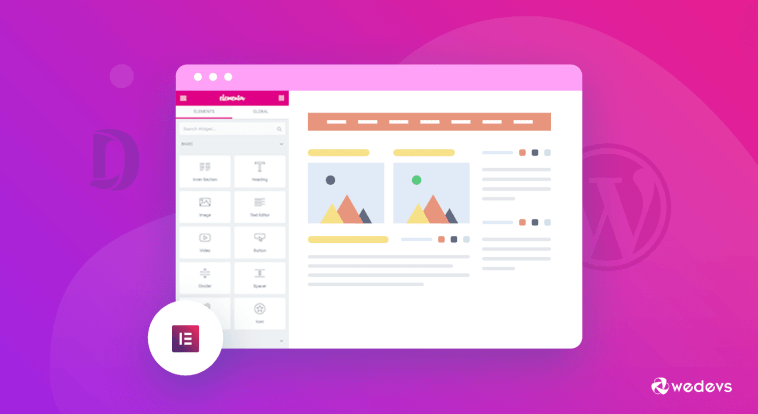Introduction.
The digital marketplace has witnessed a remarkable surge in e-commerce, with more businesses and entrepreneurs turning to online stores to reach a global audience.
If you’re looking to join this thriving industry, creating an e-commerce website is the first step towards establishing a successful online presence.
WordPress, one of the most popular website-building platforms, combined with the versatile Elementor page builder, offers a powerful and user-friendly solution for crafting an impressive e-commerce site.
In this comprehensive guide, we’ll explore how to create an e-commerce website in WordPress using Elementor.
Whether you’re a seasoned entrepreneur launching a new venture or an aspiring online store owner taking your business digital, this step-by-step guide will help you harness the full potential of these tools.
Let’s embark on this journey to build a robust and visually appealing e-commerce website that can cater to the demands of today’s online shoppers.
The Power of E-commerce in WordPress
Before we dive into the technical aspects, let’s understand why creating an e-commerce website in WordPress using Elementor is a smart choice:
- Scalability: WordPress, combined with specialized e-commerce plugins like WooCommerce, offers a highly scalable platform that can grow with your business.
- Customization: Elementor empowers you with unparalleled design flexibility, allowing you to create a unique and visually appealing online store.
- User-Friendly: Both WordPress and Elementor are known for their user-friendly interfaces, making them accessible to beginners and experienced users alike.
- SEO-Friendly: WordPress has strong SEO capabilities, helping your e-commerce website rank well on search engines and attract organic traffic.
- Plugin Ecosystem: WordPress boasts a vast plugin ecosystem, providing you with a wide range of functionalities and features to enhance your e-commerce site.
Now, let’s delve into the steps to create your e-commerce website using WordPress and Elementor.
How Do I Create an eCommerce Website In WordPress Using Elementor?
WordPress, a popular content management system, combined with the powerful Elementor page builder, provides an excellent foundation for building a stunning and functional eCommerce website.
In this guide, we will walk you through the step-by-step process of creating an eCommerce website in WordPress using Elementor.
Step 1: Choose a Domain Name and Hosting.
Before you can start building your eCommerce website, you need a domain name and hosting.
Your domain name should reflect your business and be easy to remember. Hosting is where your website’s files and data will be stored. Popular hosting providers for WordPress include Bluehost, SiteGround, and HostGator.
Step 2: Install WordPress.
Most hosting providers offer one-click WordPress installation, making this step a breeze. Once WordPress is installed, you can access your website’s dashboard by navigating to yourdomain.com/wp-admin and entering your login credentials.
Step 3: Choose an eCommerce Plugin.
WordPress offers several eCommerce plugins, but WooCommerce is the most popular and widely used. T
o install WooCommerce, go to your WordPress dashboard, click on “Plugins” in the sidebar, and then click “Add New.” Search for “WooCommerce” and click “Install Now.” After installation, click “Activate.”
Step 4: Set Up WooCommerce.
Once WooCommerce is activated, a setup wizard will guide you through the initial configuration. This includes setting your location, currency, payment methods, and shipping options. You can also customize your store’s appearance and add essential pages like the shop, cart, and checkout.
Step 5: Choose a Theme.
Now it’s time to select a WordPress theme that works well with Elementor and suits your eCommerce needs. There are numerous free and premium eCommerce themes available.
Some popular choices include Astra, OceanWP, and Storefront. After installing your chosen theme, activate it from the WordPress dashboard.
Step 6: Install and Activate Elementor.
Elementor is a drag-and-drop page builder that simplifies the process of designing your eCommerce website.
To install Elementor, go to your WordPress dashboard, click on “Plugins,” and then click “Add New.” Search for “Elementor” and click “Install Now.” Once it’s installed, activate the plugin.
Step 7: Create Product Pages.
With WooCommerce and Elementor in place, you can now start creating your product pages. Go to your WordPress dashboard and click on “Products” under the WooCommerce menu. Add your products one by one, including images, descriptions, prices, and any other relevant information.
Step 8: Design Your eCommerce Website with Elementor.
Now comes the fun part – designing your website using Elementor. Navigate to the page you want to edit, click “Edit with Elementor,” and you’ll be taken to the Elementor interface.
Here, you can use the drag-and-drop editor to customize your pages, add widgets, and create stunning layouts.
Elementor offers various pre-designed templates and blocks that you can use to create your product pages, home pages, about us, and more. You can also customize the header, footer, and other site elements to match your brand.
Step 9: Configure SEO Settings.
Search engine optimization (SEO) is essential for attracting organic traffic to your eCommerce website.
Install an SEO plugin like Yoast SEO to optimize your website’s meta titles, descriptions, and other SEO elements.
Step 10: Set Up Payment and Shipping Options.
Return to your WooCommerce settings to configure payment gateways and shipping methods. WooCommerce supports various payment gateways like PayPal, Stripe, and credit card payments. Ensure that your chosen methods are set up correctly.
Step 11: Test and Launch.
Before launching your eCommerce website, thoroughly test it to ensure that all features, products, and pages work as expected. Check the shopping cart, checkout process, and payment gateway functionality.
Conclusion.
Creating an eCommerce website in WordPress using Elementor is a powerful combination that allows you to design a beautiful and functional online store.
By following these steps, you can establish your eCommerce presence and start selling products to a global audience.
Remember that building a successful eCommerce business takes time and effort, so stay dedicated and continuously improve your site to meet the evolving needs of your customers. Good luck with your eCommerce journey!






GIPHY App Key not set. Please check settings